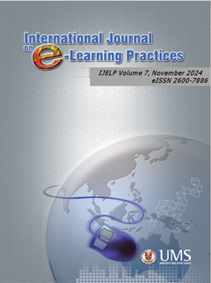BLENDED LEARNING IN TEACHING ENGLISH LITERATURE DURING THE COVID-19 PANDEMIC: TEACHERS’ PERCEPTIONS
DOI:
https://doi.org/10.51200/ijelp.v7i1.5442Keywords:
blended learning, Literature, pandemic, technologyAbstract
This study investigates teachers' perceptions of blended learning in the context of English Literature during the Covid-19 pandemic. The research aims to understand how English teachers adapted to the sudden shift from traditional to blended learning environments. The research includes exploring the strategies employed by teachers when integrating literature lessons into a blended learning approach, impacts of blended learning during the pandemic to teachers’ teaching professionalism and problems faced by teachers when designing Literature lessons during the pandemic. Four English Literature teachers from SMK Datuk Peter Mojuntin, Penampang participated in semi-structured interviews, providing different perceptions into their experiences with blended learning. The findings reveal that technology played an essential role in facilitating teaching and learning during the pandemic. The combination of traditional and digital methods allowed for a balanced approach to teaching English Literature, fostering interactive and collaborative learning experiences. Despite these benefits, the transition to blended learning presented significant challenges in terms of adaptation, professional growth and connectivity issues. The study helps to understand the implications of this research especially for researchers, teachers and students. The data gained from this study offer guidance for improving blended learning practices and addressing the needs of students and teachers in a rapidly evolving educational setting.
References
Agopian, T. (2022). Online instruction during the Covid-19 pandemic: creating a 21st century
community of learners through Social Constructivism. The Clearing House: A Journal of Educational Strategies, Issues and Ideas, 95(2), 85-89. https://doi.org/10.1080/00098655.2021.2014774
Ahmadi, M. (2018). The use of technology in English language learning: A literature review.
International Journal of Research in English Education, 3(2), 115-125.
Bond, M., Bedenlier, S., Marín, V. I., & Handel, M. (2020). Emergency remote teaching in
higher education: Mapping the first global online semester. International Journal of Educational Technology in Higher Education, 17(1), 30.
Brinkmann, S., & Kvale, S. (2018). Doing interviews. Sage.
Campbell, S, Greenwood, M, & Walker, K. (2020). Purposive sampling: complex or simple?
Research case examples. Sage, 25(8).
Corbett, F., & Spinello, E. (2020). Connectivism and leadership: harnessing a learning theory
for the digital age to redefine leadership in the twenty-first century. Heliyon, 6(1), 1-9. https://doi.org/10.1016/j.heliyon.2020.e03250
Cutri, R. M., Mena, J., & Whiting, E. F. (2020). Faculty readiness for online crisis teaching:
Transitioning to online teaching during the COVID-19 pandemic. European Journal of Teacher Education, 43(4), 523-541.
Hrastinski, S. (2019). What Do We Mean by Blended Learning?. TechTrends, 63, 564–569.
https://doi.org/10.1007/s11528-019-00375-5
George, T. (2022). Semi-structured interview | Definition, guide & examples. Scribbr.
https://www.scribbr.com/methodology/semi-structured-interview/
Kilag, O., Abalo, S., Retes, G., & Dalogdog, L. (2023). European Journal of Innovation in
Nonformal Education, 3(6).
McGrath, C., Palmgren, P., & Liljedahl, M. (2018). Twelve tips for conducting qualitative
research interviews. Medical Teacher, 41(9), 1002-1006.
Muhajirah, M. (2020). Basic of learning theory. International Journal of Asian Education,
(1), 37-42.
Murgatrotd, S. (2020). COVID-19 and Online learning.
Pokhrel, S & Chhetri, R. (2021). A literature review on impact of COVID-19 pandemic on
teaching and learning. Higher Education for the Future, 8(1), 133-141.
https://doi.org/10.1177/2347631120983481
Ratheeswari, K. (2018). Information Communication Technology in education. Journal of
Applied and Advanced Research, 3(1), 45-47.
Seixas, B., Smith, N., & Mitton, C. (2018). The qualitative descriptive approach in
international comparative studies: Using online qualitative surveys. International
Journal of Health Policy and Management, 7(9), 778–781.
Sukendro, S., Habibi, A., Khaeruddin, K., Indrayana, B., Syahruddin, S., Makadada, F., &
Hakim, H. (2020). Using an extended Technology Acceptance Model to understand students’use of e-learning during Covid-19: Indonesian sport science education context. Heliyon, 6, 1-9.
Trust, T., & Whalen, J. (2020). Should Teachers Be Trained in Emergency Remote Teaching?
Lessons Learned from the COVID-19 Pandemic. Journal of Technology and Teacher Education, 28(2), 189-199.
Van Lancker, W., & Parolin, Z. (2020). COVID-19, school closures, and child poverty: a
social crisis in the making. The Lancet Public Health, 5(5), 243-244.
Wahyuningsih, S., & Afandi, M. (2022). Incorporating English skills in blended learning
during the Covid-19 pandemic: A narrative inquiry. Journal of English Language
Studies, 4(3), 227-239. https://doi.org/10.31849/elsya.v4i2.9902






